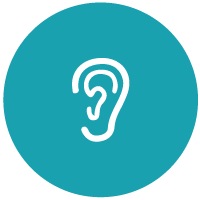COVID-19 and Successful Communication
Overcoming communication challenges related to COVID-19

COVID-19 has introduced many challenges for everyone. One of these challenges relates to how we communicate. It seems that wearing masks in public will be the “new normal” for the foreseeable future. This poses an obvious challenge as it takes away the visual cues that typically help us to hear and understand speech. This challenge is even more problematic for people who have hearing difficulties and rely heavily on lip-reading. In addition, the masks are wreaking havoc with behind-the-ear hearing aids. The elastic is sometimes uncomfortable, and it can easily get caught on the hearing aids and make them fall off when the mask is removed.
Another communication challenge is caused by social distancing. When we follow the rules and stay six feet away from those we are trying to communicate with, it can be difficult to hear what is being said, especially when masks muffle the sound.
Finally, many of us are spending more time at home and trying to learn new ways to communicate with our friends, co-workers, and family members from a distance. We may be spending more time watching TV and more time on the telephone as well, which can sometimes be challenging for those with hearing difficulties.
As your hearing and communication specialists, we want to help you overcome the challenges mentioned above. We will get through these challenging times together, and we will be here for you every step of the way.
Tips for Wearing Masks

If you are wearing home-made masks, choose those that tie behind the head, instead of those with elastic loops that go behind the ears. If you only have masks with ear loops, try to hook those loops onto something other than your ears… here are a few examples:
- Take a ribbon or strip of fabric about 4-5 inches long and attach a button on each end – then you can loop the mask ear loops over the buttons with the strip along the back of your head, and it will take the pressure off your ears. Some crafters even create these using crochet!
- Not a crafter? A twisty tie can be used at the back of the head to hold the ear loops off your ears and secure your mask.
- If you have long hair, you can pull it back into a bun, or pigtail buns, to loop the ear loops over!
- The smaller the elastic, the less likely it is to interfere with your hearing aids, so look for masks with the thinnest possible elastic (disposable surgical masks are the best).
Tips for the Speaker while wearing a mask

- Get your listener’s attention before you start speaking.
- Speak slowly and clearly. Do not over-exaggerate, but do enunciate your words clearly.
- Raise the volume of your voice slightly.
- Look directly at your listener when you are speaking.
- Ask your listener for feedback: “Are you able to hear me? Did you understand what I said?”
- Rephrase rather than repeat: If your listener has missed what you said, try to say it in a different way so that your listener has some different clues to work with.
- There are masks with clear plastic inserts over the mouth that allows for lip-reading. Ask your hearing care provider for recommendations on where to find these.
Tips for the Listener while wearing a mask

- Be your own advocate: let people know that you have difficulty hearing and need them to speak up.
- Carry a pen and paper or use the notes in your phone to have the other person write or type important information such as phone numbers and dates. Be sure to sanitize afterward!
- Don’t use the lazy “W” word….”What?” Instead, repeat back what you think you heard (“Did you say…?”), or ask the speaker to rephrase what they said.
- Understand that you may experience some exhaustion over the extra listening effort needed to communicate with masks. This is normal, so find a way to give yourself a break when you feel that exhaustion setting in.
Hearing Aid Tip
A little extra volume can go a long way when you are trying to hear people through their masks. Don’t be afraid to kick up your volume a notch when you head out to run errands. Also, don’t remove your mask until you are back in your car with the door shut. This way, if your hearing aid goes flying off with the mask, it will be safely contained inside your car instead of in the parking lot!
Video Chats

Many of us have never used video chat options before this pandemic and may be nervous to try something new. Zoom, Facetime, Marco Polo, Google Meet, Duo, and the list goes on and on; there are plenty of options to embrace the latest technology for keeping in contact with our coworkers, friends, and family during this time. Video chat is a wonderful option for people with hearing difficulties because you can see the speaker’s face and tune into their lip movements and facial expressions, which share an incredible amount of information.
Most of the video chat programs are available on smartphones. If you have a smartphone that is connected to your hearing aids, download one of the apps mentioned above. The sound from your video chat will stream directly to your hearing aids making it extra loud and clear
Your Video Chat Environment

- Choose a quiet space for video calls – this makes it easier for you to hear them and vice versa. Turn off any background noise, including TVs, radios, dishwashers, etc.
- Check your lighting to make sure that your chat partners can easily see your face. Have your room well lit, but be sure you do not have a window behind you as that will make your face appear very dark.
- Check your angle – try to center yourself in the middle of your video call screen. This makes it easier for others to see and understand you
Hearing Aid Tip
Hearing aids are meant for full-time use. Wear your hearing aids all day long so that your brain can get used to amplified sound in all situations. Even if you are home alone, it is important to hear the true (amplified) sounds around your house. And if you receive a phone or video call, you will be prepared to hear your best.
Speaker Tip for Video Chats

Sometimes the microphones on computers, tablets, or smartphones don’t work that well at picking up the sound of your voice during video chats. You can purchase relatively inexpensive boom microphones that pick up your voice and transmit it very clearly. Boom mics also help to reduce the background noise that is typically picked up by the computer microphone.
Hearing Aid Tip
Some hearing aids have remote programming capabilities. This means that your hearing care provider can make changes to your hearing aid settings by connecting to them through your smartphone. Nearly all of the new hearing aids have this capability so be sure to ask your hearing care provider about this option if you are considering upgrading your hearing aids!
A Fun Tech Tool to Stay Connected

If you are looking for a fun and unique way to keep in contact with your friends and family, consider looking into Marco Polo! Marco Polo is a fun and free app that is like video walkie-talkies. You can send videos back and forth with either one person or a group of people. This is an excellent way to keep in touch and feel connected with people you are distancing from at the moment. One great feature is the ability to pause videos, adjust volume, and replay videos as needed.
Streaming hours of phone and video calls from your phone to your hearing aids can drain your hearing aid batteries faster. If you have newer rechargeable hearing aids this shouldn’t be an issue. However, if you have non-rechargeable batteries, you might notice shorter battery life. This is normal and is not a reason to limit your streaming. Hearing aid batteries are inexpensive and easy to change, and the clarity and ease of communication that streaming allows are well worth the cost.
We hope this information has been helpful as we all learn to navigate these new waters of masks, social distancing, and video chats.
The most important point is that you are not alone. Millions of people have difficulty hearing, and millions of people are struggling with masks, social distancing, and new technology. We encourage you to be a strong advocate for yourself. Education is power, and there are many incredible resources to help you overcome these new challenges. Here are just a few to get you started:
https://livingwithhearingloss.com
Sheri Eberts is an author and speaker who has hearing loss. Her free blog offers excellent advice, education, and encouragement.
https://www.hearingloss.org
The Hearing Loss Association of America is the leading consumer organization for people who have difficulty hearing. They offer wonderful educational resources to help you overcome challenges associated with hearing loss. Here’s the link to their free webinars that cover topics such as:
Coping with Coronavirus, Face Masks, and Hearing Loss Hearing Assistive Technology at Home
https://www.hearingloss.org/programs-events/webinars/schedule-recordings/
Please reach out to us if you have any questions. We are here to support you through every step of this new journey.